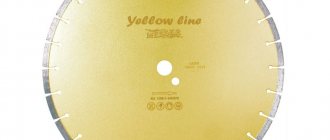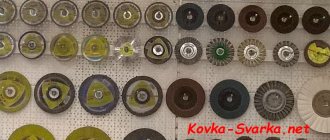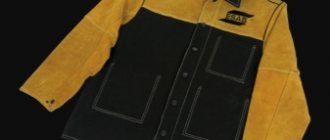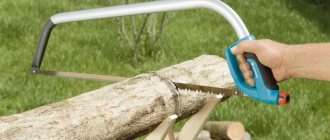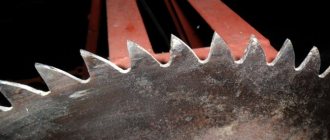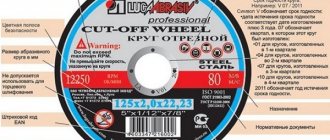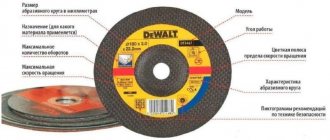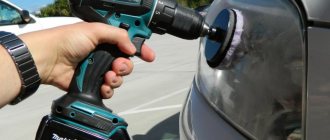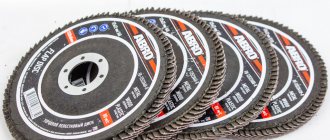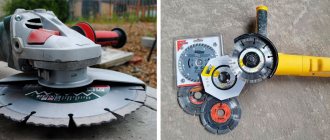The variety of work performed with the help of grinders is largely ensured by the wide range of tools that work with them.
For each standard size angle grinder, you can always select consumables that correspond to the characteristics and dimensions. One of the parameters that determines the capabilities of an angle grinder is the maximum diameter of the disk that is installed on it. It determines the speed, engine power and torque. The choice of disk size is closely related to the nature of the work performed by the grinder.
Types of circles
The circles (disks) of grinders differ according to the following indicators:
- work performed that determines the purpose of the tool;
- composition of the material;
- dimensions.
Technological features
The necessary processing technology is provided by the following consumables.
- — Cutting wheels. Mainly used for processing metals, less often for other types of materials.
- — Grinding wheels. Different designs allow you to perform both roughing or cleaning, and bringing the surface roughness to the desired condition.
- — Polishing discs and attachments. Bring the surface to a shine using felt or other fabric with similar properties.
By material
The operating modes are influenced by the material component from which the tool is made.
- — Abrasive disc. The basis that served for the manufacture of the tool is the abrasive material itself, a binder, for example, bakelite and various fillers. Mainly used for metal processing.
- — Diamond wheel (with diamond coating). With its help, you can process materials of any strength (various types of stone, ceramics, quartz glass and many other similar ones consisting of solid fractions).
Dimensions
The main classification criterion here is the diameter of the disc. The depth of the cut depends on its size (it is approximately a quarter of the diameter). The functionality of an angle grinder is determined by the size of the tool: a small diameter makes it possible to process a light angle grinder in hard-to-reach places, while a larger size angle grinder with greater productivity will be difficult and unsafe to hold “in weight”.
Main characteristics of cutting wheels
Depending on the material of manufacture and design features, there are three main types of circles:
- An abrasive disc for a wood grinder, used for working with various surfaces. Depending on the thickness, the wheel can be used for cutting and grinding.
- Diamond blade designed for working with stone, concrete and other building materials. Such circles are divided into segmented and solid. The first type, due to better removal of the stump through the slots and more efficient cooling, ensures high productivity. These blades can be used when cutting thin metals.
- A regular circle for a circular saw. However, it is immediately worth noting that it is not recommended to use it for cutting wooden products without experience, since there are many cases where people received quite serious injuries when clamping a disk in an array. If possible, when performing such work, it is better to use another tool, for example a jigsaw, chainsaw, etc.
Marking
The choice of the right tool is facilitated by the presence of markings. It contains the technical parameters of consumables in encrypted form. For example, this is what an alphanumeric set of markings for a cutting disc looks like, produced by a Russian manufacturer:
- — The image shows the tool manufacturer — Luga Abrasive Plant (Luga, Leningrad Region).
- — Tool name:
- cutting wheel - in Russian;
- cut –off – wheel – in English translation.
- — Purpose: for processing steel (inscriptions “steel”, “steel” on the circle).
- — The dimensions of the circle are indicated (outer diameter x thickness x bore diameter):
- in mm – 200 x 2.5 x 22.23;
- in inches – 8”x 1/10”x 7/8”;
- digital designation "41". This is a characteristic of the design of the circle - here it is flat.
- — The circle is designed for 7650 rpm, while the maximum peripheral speed should not exceed 80 m/s.
- — Technical parameters of the wheel material are determined from the designation “A 30 S BF”, where:
- A – means that the abrasive is based on white electrocorundum, which is specifically used for metal processing;
- 30 – abrasive grain size, here it is average;
- S – hardness of the circle, here the circle is hard;
- BF - denotes the type of bond, here synthetic resins with glass fiber reinforcement.
- — Rules for safe work in the form of signs indicating the required action.
- - GOST 21963 - 2002, GOST R 52588 - 2011, EN 12413 - Russian and European regulatory documents to which this tool complies.
The marking of a foreign manufacturer of tools for angle grinders is as follows:
- — Tools under the NORTON VULKAN brand are produced by the Saint Gobain corporation, headquartered in France.
- —The purpose of the cutting disc (the company produces only such a tool for angle grinders) for processing steel (in addition, for visualization purposes, the label for wheels intended for metal processing is blue) is duplicated in several languages.
- — The circle is designed for 12250 rpm with a maximum peripheral speed of 80 m/s.
- — The dimensions are the same as on the Russian disk - in mm and inches.
- — The digital designation “41” has been added to the technical parameters of “A60S – BF41”. This is a characteristic of the design of the circle - here it is flat.
- — Methods of safe work must be indicated.
- — The regulatory documents to which the instrument complies are issued by the European Union.
Shape of abrasive discs
Abrasive wheels differ in their shape. There are:
- Standard flat discs.
- Curved discs (in the form of a plate). They can be used when performing work in hard-to-reach places. With this circle shape, the locking nut is hidden, making grinding work more convenient.
When purchasing a disc for an angle grinder for wood, pay attention to the marking (for example, A 40 L), which allows you to find out the following information about the product:
- The first letter (or two) indicates the type of abrasive used. For example: A - corundum, AS - electrocorundum, C - silicon carbide, which is used when working on granite and stone.
- The numbers allow you to find out the grain size of the abrasive. Moreover, the larger it is, the faster the work will progress. However, this will reduce the cleanliness of the cut or grind. A disk with a coarse grain is used, as a rule, for processing soft (non-ferrous) metal, and a disk with a fine grain is used for steel.
- The last letter in the marking indicates the hardness of the ligament of the base of the circle (those letters that are located at the beginning of the alphabet mean that the ligament is softer). When purchasing, it is recommended to follow this rule: when working with soft material, use a disc with a soft bond and vice versa.
Almost all manufacturers of abrasive wheels use color marking of their products. Green is for stone, blue for metal work. It is also worth mentioning about the inner seat ring. For wheels intended for cutting, it is made of hard metal, while for polishing or grinding, cutting discs with a softer washer are used.
What are the sizes of wheels for angle grinders Bosch, Interskol and more?
Almost all large companies produce grinders covering the maximum number of works - from household to industrial designs. Each type has its own tool size. In addition to the production of angle grinders, such manufacturers (Bosch, Metabo, Interskol and others) have mastered the parallel production of consumables. They select a special composition and standard size of consumables in order to maximize the operating efficiency of the specific model they produce.
Outer and bore diameter, maximum and minimum value
The most popular range of angle grinder sizes consists of the following values.
External diameter . The most preferred sizes are: 115 mm, 125 mm, 150 mm, 180 mm, 200 mm and 230 mm. In rare cases, to perform, for example, jewelry work with small parts, portable battery-powered angle grinders with diameters of 76 mm or 100 mm are used.
The minimum diameter of 115 mm is used for simple work in the form of processing hard-to-reach surfaces in the household. Anglers with a circle with a diameter of 125 mm have greater ability to perform various household works.
The diameter of 230 mm is used in the professional context of angle grinders for large volumes of work, for example, in construction. Circles with a diameter of more than 230 mm are installed on stationary equipment.
Thickness _ Cutting wheels are available in thicknesses from 0.8 mm to 5.0 mm. Moreover, a larger diameter should have a circle with a correspondingly greater thickness.
You should know! A thin disc is easy to cut, but it is also more likely to break.
Landing diameter . The standard mounting diameter for angle grinder consumables is 22.23 mm. In the vast majority of cases, it is the same for all disk sizes. It is rare to find mounting diameters of 10 mm, 13 mm, 16 mm due to the limited use of angle grinders with a diameter smaller than 100 mm. A 32 mm bore diameter is used with circles of 300 mm and larger on stationary equipment.
What features of grinder wheels should you pay attention to when choosing?
There are not many nuances in this matter (choosing household appliances is much more difficult), so study them thoroughly.
- Typical circle sizes. The outer diameter of the disc cannot exceed the maximum permissible values set for your angle grinder. Otherwise, the linear speed of the cutting edge will be constantly exceeded, and this is fraught not only with the destruction of the disk itself, but also with the user receiving significant injuries - after all, the protective casing will have to be removed! In addition, a small unit simply does not have enough power for high-quality work. There are several standard sizes: 115, 125, 150, 180, 230 mm. All the necessary information is printed on the circle (thickness, diameter, maximum rotation speed, etc.).
- Purpose. They are divided into 4 types: cutting, roughing, grinding and sharpening. Cutting discs are suitable for metal work (blue, made from crystalline or synthetic corundum); stone, slate and sand-lime brick (material - silicon cabbage, color - green); diamond (for red brick, concrete, ceramic tiles and porcelain stoneware, made of metal with diamond chips in the form of an abrasive mass); on wood (requiring special safety measures, as they often slip or bounce off). Peelers help remove the old layer of paint and rust (they are made in the form of a bowl with bundles of wire of different thicknesses or a disk). Grinding - assistants in polishing and grinding wood, metal, plastic and other surfaces.
- Material. They can be abrasive and diamond. Diamond ones are used when processing quartz glass, ceramics, quartz and other durable materials; abrasive ones work well with metals.
Reference! Don’t rush to throw away the old grinder you inherited from your father: even if its bore diameter does not coincide with current standards (the modern figure is 22.2 mm), you can buy special adapters and use the device without problems.
For large, medium and small angle grinders
The power classification into small, medium and large is closely related to dimensions and weight. The greater the power, the greater the weight and overall dimensions.
So, for example, grinders with disks of 115 mm - 125 mm and a power of 0.6 kW to 1.2 kW are classified as small equipment.
Angler grinders with discs of 150 mm - 180 mm and a power of up to 2.0 kW belong to the middle class of such equipment.
Professional angle grinders with a power of up to 3.0 kW and a disc diameter of 230 mm conventionally belong to large angle grinders.
Safety regulations
When working with an angle grinder, regardless of what type of disc is installed, it is necessary to strictly adhere to safety requirements.
- The tool must be equipped with a stop handle and a protective casing.
- All work must be performed in special clothing and using personal protective equipment. It is also necessary to be very careful when choosing glasses or a mask, because eye damage (statistically, this is the most common injury) can be caused even by small shavings or a fragment of the circle itself.
For metal, concrete, wood and other materials
To effectively process any material, it is important to choose the right power so that it matches the diameter of the tool and its thickness. In addition, the consumable must have suitable characteristics for processing a specific type of workpiece material.
The main difference between discs for steel, cast iron, and non-ferrous metals is in the composition of the fillers. To process alloy steels, a very strong additive is added to the disc material that can overcome the resistance of alloy steel. When processing non-ferrous metals, on the contrary, a soft filler is added, which works effectively when processing viscous materials.
Disc for aluminum
To process concrete (tiles, paving slabs), diamond discs are used (actually, these are metal circles coated with diamond).
Tile disc
It is not recommended to process wood with an angle grinder due to the high risk of injury. If such a need nevertheless arises, then the best option would be a grinder with a disk with a diameter of 125 mm. As a working tool, special angle grinder discs for wood should be used.
Wood disc
Diamond cutting wheels for grinders
Depending on their purpose, diamond discs can be divided into several types:
- Concrete. Circles of this type can easily cope with monolithic structures, including concrete and reinforced structures.
- Granite. Such discs are used when working with particularly hard stones.
- Asphalt. Cutting wheels are best used when processing concrete and, accordingly, asphalt.
- Construction Materials. Discs of this type can be used for cutting ceramics and bricks.
Diamond cutting wheels from some manufacturers are also color coded:
- Green is granite.
- Blue - concrete, marble.
- Yellow - plaster, tile.
- Gray - ceramics.
Segmented diamond cutting wheels are used for cutting materials using the dry method. When using solid discs, wet cutting (water cooling) is used. This is primarily due to the very high heating of the continuous surface of the cutting wheel.
There are models that have partial segmentation. These are so-called turbo discs, in which the slots are located in the body of the circle (they do not extend to the outer edge). Such products can be used at higher speeds than fully segmented ones.
So, by choosing the most suitable cutting disc for a wood grinder in all respects, you can perform any work efficiently and safely.
How to choose
The main criterion for choosing the disk size will be the nature of the work performed. In the household, these will be circles of smaller diameters; in a production environment, a tool of large diameter (230 mm) is used.
In addition to the dimensional characteristics, you should carefully check the compliance of the disc material with the material of the workpiece being processed.
Another determining factor is the power of the grinder. It is directly related to the weight and overall characteristics of an angle grinder. With approximately the same characteristics, preference should be given to a lighter specimen.
Each type of work has its own disk
It is important to use your own disk for each type of work. Cutting wheels cannot be used for stripping and vice versa. Based on this, it is possible to divide the types of disks by type of work.
- If it is necessary to cut or saw, then use cutting discs.
- If you have to cut wood products, use saw blades.
- If you need to peel off old layers of paint and varnish materials and primer or make the surface smooth, you need a roughing or grinding disc.
- You can process metal, wood, and plastic products with a flap disc.
- For final polishing of surfaces, a polishing disc is best.
How to replace
The grinder disc is a consumable item. Therefore, it has to be changed frequently. There is a simple algorithm in which an important role is played by the original design of the key supplied to the consumer along with the grinder.
- — The protruding rods of a special key are installed in the grooves of the fastening nut.
- — At the same time, press the lock button located on the gearbox housing. It will lock the rotor from turning.
- — Turn the key counterclockwise to release the fasteners of the worn disk.
- — The old disk is replaced with a new one of the same technical characteristics and size. The new disk is installed with the markings facing out to remind you of the disk parameters and for other good reasons (see explanation in the video above).
- — The fastening nut is first tightened by hand and finally tightened with a special wrench.
The Bulgarian is ready to continue fulfilling its functional purpose.
